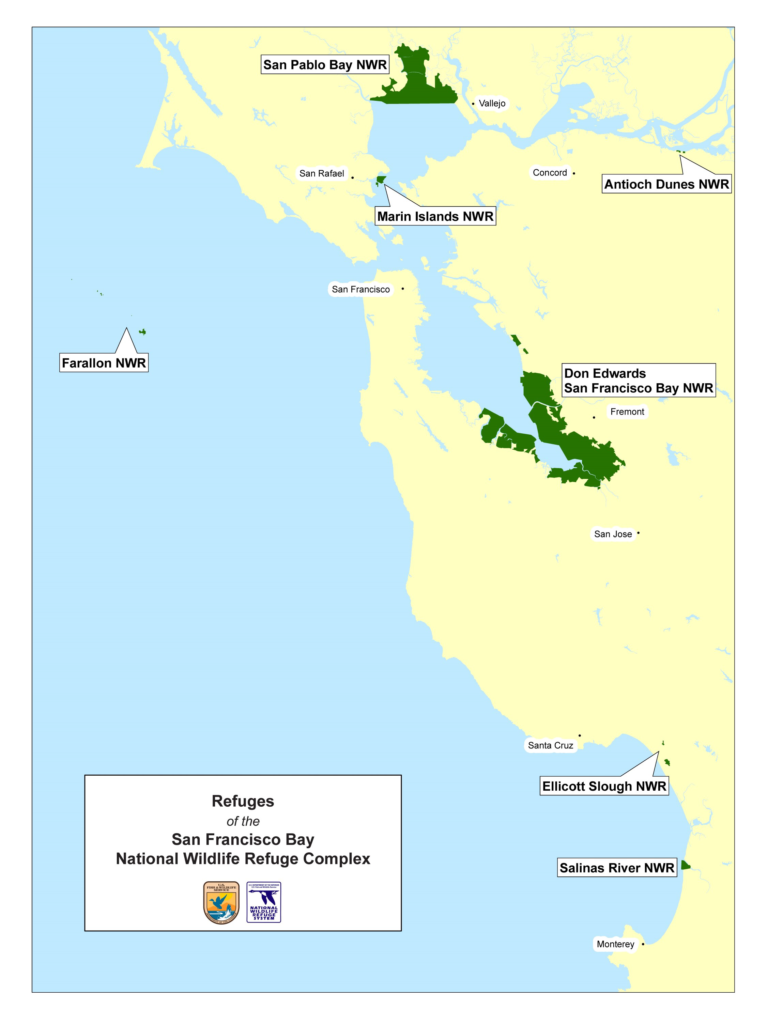Story from Marcia Brown, Foundations of Success, and Giselle Block, U.S. Fish and Wildlife Service
The San Francisco Bay National Wildlife Refuge Complex is a collection of seven National Wildlife Refuges administered by the U.S. Fish and Wildlife Service (USFWS). The complex includes Don Edwards San Francisco Bay National Wildlife Refuge (NWR), Antioch Dunes NWR, Ellicott Slough NWR, Farallon Islands NWR, Marin Islands NWR, Salinas River NWR, and San Pablo Bay NWR (see map below). Not far from the cable cars of San Francisco and the tech giants of Silicon Valley, these Refuges protect salt marsh, sand dunes, rocky offshore islands, estuarine islands, vernal pools, tidal flats, migratory birds, endangered species and other fish, plants, wildlife and their habitats. They also provide public recreation and educational opportunities to a densely populated and culturally diverse urban area.
The Complex faces increasing challenges and shrinking budgets. Ecosystems and species in the Complex are threatened not only by invasive species, predation, disturbance, potential oil spills and other typical threats, but also climate-related stresses, such as sea level rise, extreme weather events, ocean acidification and changes in precipitation and temperature. Despite the increasing cost of addressing climate change and other threats, since 2010 the National Wildlife Refuge System’s national budget has decreased by $20 million and the San Francisco Bay Complex’s staff has been reduced by 14%.
With help from Foundations of Success (FOS), the San Francisco Bay NWR Complex is using the Open Standards to undertake a conservation planning and work prioritization process that will guide the optimal allocation of limited funding and staff capacity. The process has involved adapting the OS to make it climate-smart. For example, during the Conceptualize step of the OS, USFWS conducted a review of climate change literature and summarized projected changes in temperature, precipitation and other abiotic climate factors under two climate scenarios (hot/dry and warm/wet). The team used this information to develop conceptual models for each conservation target that include not only typical direct threats and their contributing factors, but also climate stressors represented as direct threats.
USFWS staff are currently writing the San Francisco Bay Complex Natural Resource Work Plan. Once completed, they will make it publicly available. Other plans developed using the Open Standards include the Natural Resource Management Plan (NRMP) for Anaho Island National Wildlife Refuge, the NRMP for the Humboldt Bay National Wildlife Refuge (publication pending), the San Pablo Bay NWR Climate Adaptation Plan, and the Seal beach NWR Climate Adaptation Plan (publication pending).
For more information, contact: Giselle Block, U.S. Fish and Wildlife Service, Arlyne Johnson or Marcia Brown, Foundations of Success.

The San Francisco Bay National Wildlife Refuge Complex is a collection of seven National Wildlife Refuges administered by the U.S. Fish and Wildlife Service (USFWS).
